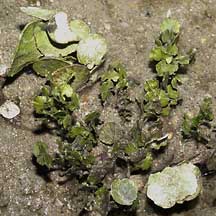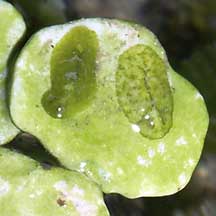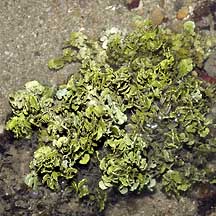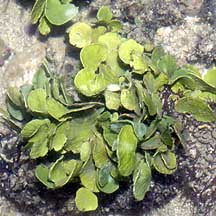 |
|
|
green
seaweeds text index | photo
index
|
| Seaweeds > Division Chlorophyta |
| Coin
green seaweeds Halimeda sp.* Family Halimedaceae updated Jan 12 Where seen? These seaweeds are made up of small, hard segments that are joined together. They are commonly seen on many of our shores, usually growing on coral rubble or among living corals, as well as in sandy areas near reefs. Sometimes forming rather large 'thickets' covering an area of 40-50cm. Features: An upright chain of joined up coin-like flattened segments. Each coin-like segment is hard as it is impregnated with calcium carbonate. These segments may be circular or other shapes, some are thick and flat, others thinner with crinkled or ruffled edges. The portions between the segments are not calcified, so the 'string' of coins is rather flexible. A new segment develops from the top and can appear rapidly, within 1-2 days! In some species, the segments are anchored by one large long bulbous holdfast. In others by a small holdfast of matted filaments, and yet others in inconspicuous patches of root-like structures emerging from segments or nodes. These seaweeds can relocate their chlorophyll (the green pigment used in photosynthesis). At night, chlorophyll might be concentrated in the centre of the segment. As a result, the seaweed may appear white. In addition to calcium carbonate, they also have chemicals that protect them from herbivores. Despite this, some slugs like the Halimeda slug (Elysiella pusilla) actually eat the seaweed and incorporates these chemicals into their tissues to protect themselves! The calcium carbonate released from dead Halimeda seaweeds are said to make major contributions to sand in some areas such as the Bahamas and the Great Barrier Reef. According to AlgaeBase, there are 60 current Halimeda species. |
 Big and small coin green seaweed next to one another Kusu Island, May 05  A pair of Halimeda slugs on the seaweed. Labrador, Mar 05 |
|
*Species are difficult to positively identify without close examination of internal parts.
On this website, they are grouped by external features for convenience of display.
| Halimeda
species recorded for Singapore Pham, M. N., H. T. W. Tan, S. Mitrovic & H. H. T. Yeo, 2011. A Checklist of the Algae of Singapore.
|
Links
References
|
|
|

